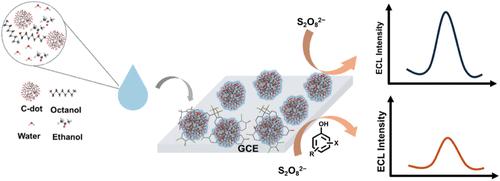用于卤化酚超灵敏检测的碳点电化学发光传感器的定向组装
IF 6.7
1区 化学
Q1 CHEMISTRY, ANALYTICAL
引用次数: 0
摘要
开发简单、灵敏、小型化的传感器是预防和控制环境中卤代酚类污染物的关键。在这项工作中,定向碳点组件首次开发用于电化学发光(ECL)传感卤化酚醛污染物。利用三元溶液蒸发过程中的液液相分离,碳点(C-dots)在疏水玻璃碳表面自组织成介孔结构(o-Cdots)和颗粒结构(r-Cdots),从而实现固定化C-dot ECL传感器。在0.1 mol/L pH为7.4的PBS中,以S2O82 -为催化剂,进行阴极电位扫描,显示出其优越的ECL性能。与亲水性o-Cdots相比,疏水性r-Cdots具有较强的ECL。卤化苯酚在疏水性r-Cdot表面的物理吸附显著提高了界面电荷转移的阻力,并破坏了r-Cdot ECL中中间C-dot•-和SO4•-的重组,为新型广谱传感器的开发提供了条件。基于r- cdot的ECL传感器能够在5 × 10-11至5 × 10-7 mol/L的宽浓度范围内检测几种典型的卤代酚类化合物。值得注意的是,2-氯酚的检出限甚至可以达到10-14 mol/L。开发的ECL传感器还显示出出色的稳定性和对环境中常见离子和天然代谢物干扰的抵抗力。这些特性使其在检测湖水和自来水中的卤化酚方面具有优异的性能,在不同的峰值水平下具有理想的回收率。这项工作为c点组装结构与其ECL行为之间的关系提供了重要的见解,为合理设计用于污染物检测的便携式c点传感器铺平了道路。本文章由计算机程序翻译,如有差异,请以英文原文为准。

Orientational Assembly of Carbon Dots-Enabled Electrochemiluminescence Sensors for Ultrasensitive Detection of Halogenated Phenols
Developing simple, sensitive, and miniaturized sensors is crucial for the prevention and control of halogenated phenolic pollutants exposed to the environment. In this work, oriented carbon dot assemblies are developed for the electrochemiluminescence (ECL) sensing of halogenated phenolic pollutants for the first time. Leveraging liquid–liquid phase separation during ternary solution evaporation, carbon dots (C-dots) self-organize into mesoporous structures (o-Cdots) and granular structures (r-Cdots) on the hydrophobic glass carbon surface, enabling immobilized C-dot ECL sensors. Their superior ECL performances are displayed upon cathodic potential scan in 0.1 mol/L pH 7.4 PBS with the coreactant S2O82–. Compared to hydrophilic o-Cdots, hydrophobic r-Cdots exhibit robust ECL. Physical adsorption of halogenated phenols onto the hydrophobic r-Cdot surface significantly elevates the resistance of interfacial charge transfer and disrupts the recombination of intermediate C-dot•– and SO4•– within the r-Cdot ECL, endowing a novel and broad-spectrum sensor development. The r-Cdot-based ECL sensor enables the detection of several typical halogenated phenolic compounds in a wide concentration range from 5 × 10–11 to 5 × 10–7 mol/L. Remarkably, the detection limit for 2-chlorophenol can even reach 10–14 mol/L. The developed ECL sensor also demonstrates outstanding stability and resistance to interference from common ions and natural metabolites in the environment. These peculiarities enable its superior performance in detecting halogenated phenols in lake water and tap water with ideal recoveries at different spike levels. This work offers significant insights into the relationship between C-dot assembly structures and their ECL behaviors, paving the way for the rational design of portable C-dot-based sensors for pollutant detections.
求助全文
通过发布文献求助,成功后即可免费获取论文全文。
去求助
来源期刊

Analytical Chemistry
化学-分析化学
CiteScore
12.10
自引率
12.20%
发文量
1949
审稿时长
1.4 months
期刊介绍:
Analytical Chemistry, a peer-reviewed research journal, focuses on disseminating new and original knowledge across all branches of analytical chemistry. Fundamental articles may explore general principles of chemical measurement science and need not directly address existing or potential analytical methodology. They can be entirely theoretical or report experimental results. Contributions may cover various phases of analytical operations, including sampling, bioanalysis, electrochemistry, mass spectrometry, microscale and nanoscale systems, environmental analysis, separations, spectroscopy, chemical reactions and selectivity, instrumentation, imaging, surface analysis, and data processing. Papers discussing known analytical methods should present a significant, original application of the method, a notable improvement, or results on an important analyte.
 求助内容:
求助内容: 应助结果提醒方式:
应助结果提醒方式:


